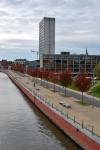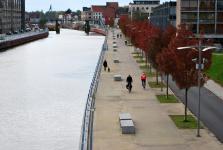The idea behind the development of Diksmuidekaai is to improve connection between the northern part of the city of Kortrijk and its riverfront, using a linear design with the capacity to address the metropolitan scale.
The use of concrete as the sole pavement material gives the space unity, increases its apparent width and provides continuity from the buildings to the river. The concrete for the cycle lanes is yellow-coloured, introducing a long linear element that connects the new spaces of the Diksmuidekaai with neighbouring areas and institutes a larger scale. As the pavement lining the façades of the buildings conceals various utilities that require maintenance (electricity, telephone, etc.), the concrete is applied in a format that can be easily replaced.
The continuity provided by the use of a single form of paving does not necessarily contradict the need for clear segregation of the various uses. In this case, street furniture is the means adopted. Unobtrusively positioned benches, small low streetlights and wastepaper bins define areas within the overall platform that are devoted to vehicles or pedestrians, thereby avoiding conflict.
The resulting positions of the various uses (a pavement next to the buildings, then traffic lanes, followed by bicycle lanes and a wide space for pedestrians to stroll by the riverside) create a fluid, well-organized public space that opens up a new leisure area for the city and paves the way for a new axis along the river to connect Kortrijk with neighbouring communities.
2003
2003










